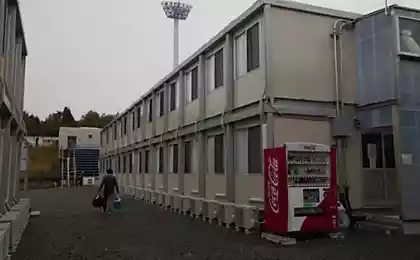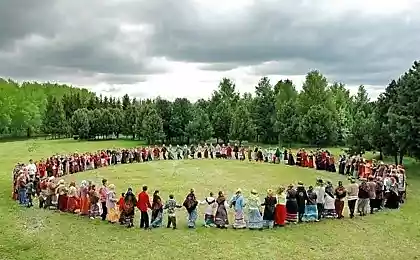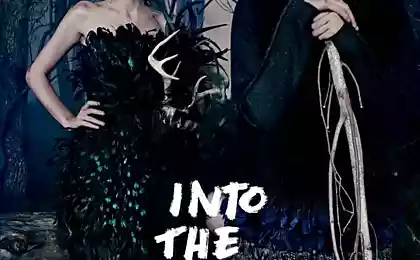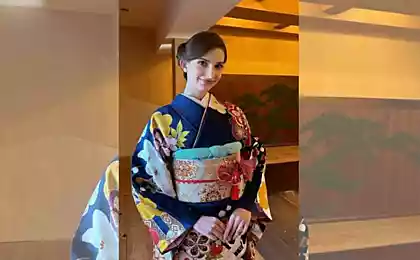1343
Walk with geisha
In Japan, it survived several specific areas that are centers of traditional Japanese art. One of them is the Gion in Kyoto Koba where we will visit today, to observe one of the geisha and get acquainted with local traditions. In Japan, a geisha is called "geiko", which means "people of art" instead of the word "geisha" means "the actress» ...
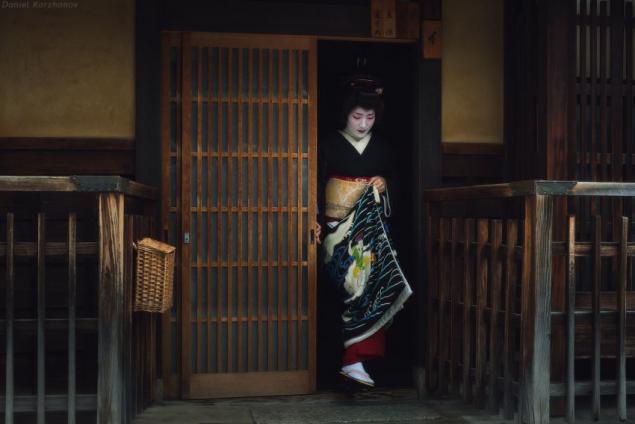
People come to the teahouses ("ochaya") to get an aesthetic pleasure to talk with geiko and maiko on different themes - art, music, literature, take part in a tea ceremony, listen to music (for example, to play the geisha shamisene) and see traditional dances.

To become a geisha, you must pass a difficult path: from the earliest years, children were taught dancing, singing, playing various musical instruments, etiquette and special dialect, which ought to talk with customers, visitors ochaya. Learning takes place at the expense of okiya ("okiya" - geisha house). The owner of okiya, a business woman with a firm grip, provide young girls with everything necessary for work, serving as a kind of agent between the okiya and ochaya (teahouses).
Careers of the future began to apprentice geisha, assistant. Then the girl became "Mike" ("Woman Dance", a young geisha). At about age 20 takes that same event that we are witnessing - erikae, which means "for tightening the collar." The fact that Mike at each dressing to an item of clothing is sewn collar. It was originally red, but eventually it embroidered with silver, gold and white thread. Embroidery tell the story of Mike. When the child becomes an adult, the red almost disappears under the embroidery. But when Mike becomes a geiko, it changes to a completely white collar. This - a symbol of its independence, maturity. On the day erikae geiko should bypass the teahouses in their karyukai (in his area) and to welcome all owners ochaya with whom she worked, all-all his friends. The ceremony lasts about 4-5 hours.

Now Gihon there are not so many teahouses, but say the tradition is gradually being revived - and the number of geishas every year gradually increases. But the problem is also in the fact that Kyoto - one of the most popular destinations for tourists from all over the world. Therefore Geisha primarily affected by journalists and paparazzi. And no wonder - the geisha less than a thousand (although before the war, there were about 80 thousand!). Therefore, for any appearance of a geisha on the street begins the real "hunting for geisha." The poor girl has no choice but to travel by taxi from the house to the house. Needless to say, the date of the erikae trying to keep secret - but there are rumors rumors and dedicated photographers gather in front of Kyoto okiya hoping to get some beautiful shots of a Geisha.
So you can imagine such an amazing picture: geisha, along with his "bodyguard", passing through the narrow alleys of Gion, persecuted crowd of tourists and journalists, as the brightest star of cinema. Many photographers charge even with folding ladder to climb above others ...
If you want to see geisha in these days, that's the best way - to come to the Miyako Odori ("Dance of the Cherry"), a theatrical performance with dancing and maiko geiko. The event takes place in April. Another wonderful holiday - Gion Mattsuri, held in July. On holidays drained a huge number of people. Generally speaking, in Kyoto in Gion, a wonderful walk in the rain or in the early morning - when the streets of very few people. Every street looks as if it is not less than a thousand years. And to the east of Gion is a pagoda and Yasaka Shrine, also an amazing place, one of the favorite places for the observation of the Japanese flowering cherry. So I, moving in the night from the streets to the street between pagodas and rickety bamboo sheds, felt a chill running through on the back seemed to legends and stories about ninjas and samurai here alive. This is the real Japan.
But back to our "hunting geisha", we catch up with our beauty and look at it from the outside. Movement geiko sharpened even during the greeting or opening doors ochiya. A walk is also unusual: a kimono requires very straight posture. Knees bent at at geiko and toes slightly apart. Therefore, gait appears from mincing, clubfoot - but no swings and kimono clothing items do not slip. The outer, physical beauty is no less important in the art of geisha than her knowledge and skills.
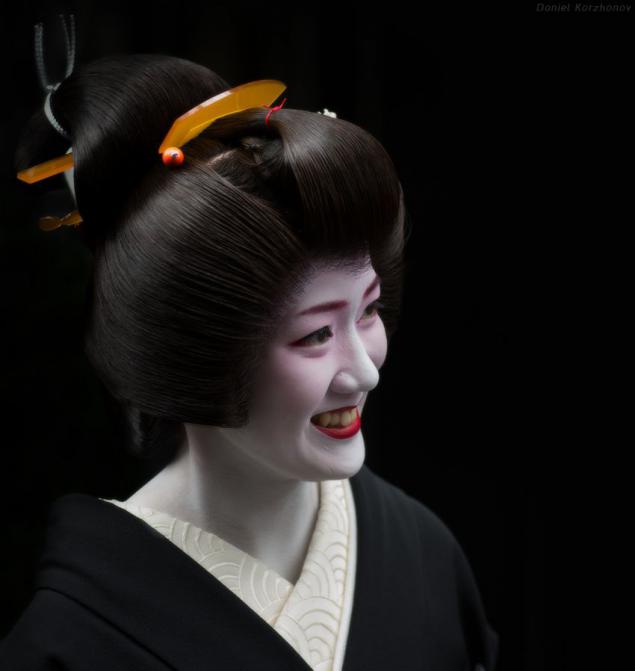
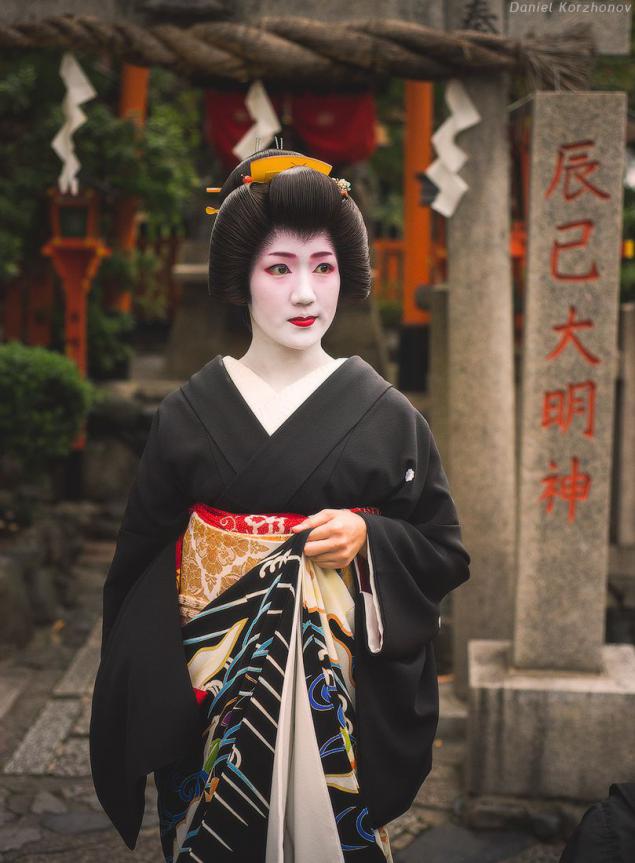
Stomp geisha special sandals ("okobo"), and on his feet dressed funny at first glance, white socks, in which the thumb is detached from the rest - as mittens. Of course, in sandals height 10-15 cm is very difficult to walk, but still and taking into account the weight of the kimono, which may even reach 15-20 kg! It is not surprising that there is even such a profession - "odevalschik" geisha. Each kimono, every detail must be adjusted, assembled as an expensive car, and decorated on the body of a woman. The most important thing to aspire to a geisha - perfection. Excellence in appearance, in dance, in the knowledge of the intricacies of the tea ceremony. To a large extent on the nature of geiko and maiko, their vital status can tell you the kimono. Kimono can hardly contain details, but everything is in the details: sew ornaments, symbols embroidered on fabric. The characters, for example, correspond to the seasons: maple leaves in November, plums in February or in early March, the nightingales. Overall, the Japanese tradition of 28 seasons. Each kimono - individual work, is the whole work of art. Of course, this kimono maiko or geiko any comparison do not go with those that are now popularly photographed for Facebook among young people undergoing a promenade at the tourist spots of Kyoto. The cost of the kimono can reach several thousands (or even tens of thousands) of dollars.



Interesting hairstyle and geiko: say it contains many sharp objects that the girl was able to defend themselves from clients who go too far. From the hairstyle looks perfect. Maiko and geiko are its 5 days a week. It just does not pass: over time, in geiko bald pate, because that constantly put pressure on the hair. But notice this is not possible, if the hair is collected. Geiko and maiko are left on the neck 2 or 3 vertical stripes with filled powder, and left ears open. The Japanese have accepted that the neck and ears - the most beautiful parts of the body. And stripes can visually lengthen the neck to make it more graceful.


Generally, until recently, work has been shrouded in mystery geisha and speculation. And even now there are ambiguities caused by incorrect interpretation of the term, historical events. Thus, people only superficially familiar with the culture of Japan may confuse geisha with courtesans. In the west, it is due in part to the well-known book of Arthur Golden, "Memoirs of a Geisha" (and the same film), where the author of many artistic speculation, especially about the intimate life of a geisha. In fact, everything was quite different: the geisha life has never been linked to close relationships with clients. Their task - to ensure cultural leisure people. Even within the system okiya, geisha houses, forbade men to appear at a party. Of course, wealthy clients often tried to "bribe" the girls gifts, but life geiko was strictly regulated and it just was not the place long-term relationships with men. Adult independent geisha thus able to have a family, but she no longer lived in the okiya.

Now tourists can offer short tea ceremony with maiko or geiko, but you need to understand that they will be significantly different from the authentic Japanese tea ceremony, which is still the main key is not fun, and talk, play, cultural leisure. And, unfortunately, in the arsenal of knowledge is not part of a Geisha Languages. Traditionally, a person can be a client ochaya only on the advice: since women were more confident that the client will be decent. Sometimes, it even took the form of family traditions: the client of the same tea house can be a whole family, and then to their children for generations.
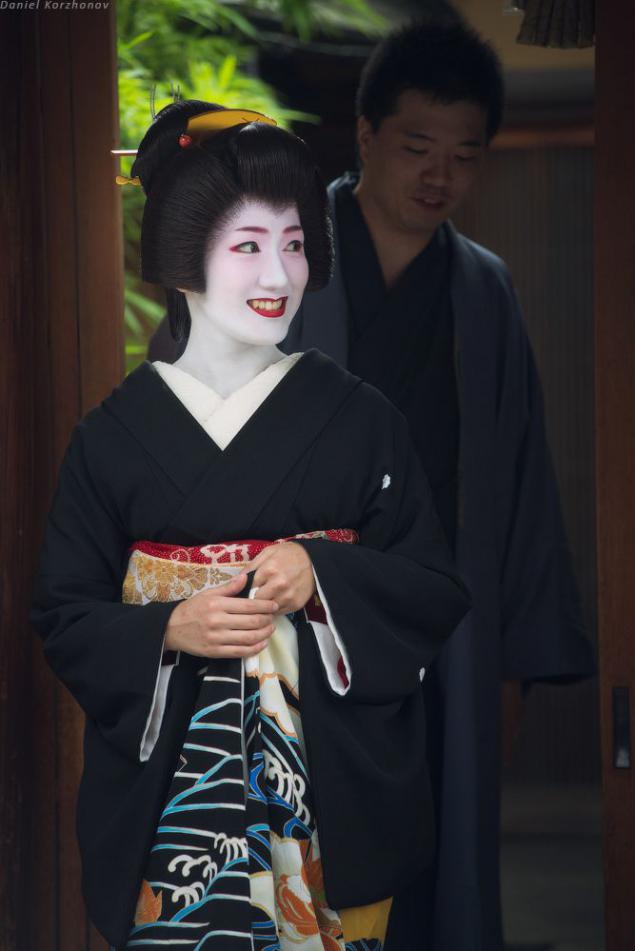
Tea ceremony itself ("ozashiki" or "banquet" - essentially the same as the name of a room for ceremonies) can start with a dance to continue the conversation on the topic of music and art, and end with a game of cards. The dance is different from ballet - although similar to it in that it requires almost the same skill balancing, balance, and what is required of a ballerina. Movement is more measured, not as sharp as in ballet. Movement in dance - a set of specific postures ("kata"), which are then combined into a single plot. Geiko should be familiar with the art of ikebana, new items of literature, to be able to draw well. Often, customers are treated to delicacies or dinner. In ochaya not cook, and bought in good restaurants. This tea ceremony can cost the client $ 500 per hour (this is the "classical" price is not the most famous maiko). All subjects participating in the ceremony, as if with his soul - made by hand with love. Each thing has its own importance. Similarly, any movements, gestures geiko during ceremonies, honed over the years, have their own meaning.
Well, having become acquainted with the Japanese beauty, as if descended from the engravings and paintings of the 18th century princess Heyyan, we say goodbye to her at the door of okiya, wishing her a successful career - in the guise of geiko.

Behind the scene, or how hard it was to shoot this small report. The Japanese are very aggressive, in actual fact. Only dedicated to know about the ceremony. Otherwise, it would be even worse. I was just lucky - often say to passers-by! ;)

In Kyoto, a scene - is not uncommon. Teens like to walk in a kimono, more often - with his loved ones.
Sometimes the streets allowed special "Geisha" - to shoot. Take a fee for it.

To see the streets of geisha should either come to the Miyako Odori Festival (April) - when a geisha and maiko dancing at local theaters, and sometimes return home through the narrow streets of Gion Kobu. Or come to the festival Djidan Matsuri in October. The procession of the festival you can always catch a beautiful view of a Geisha.

And the kids in kimonos, too wonderful! :)

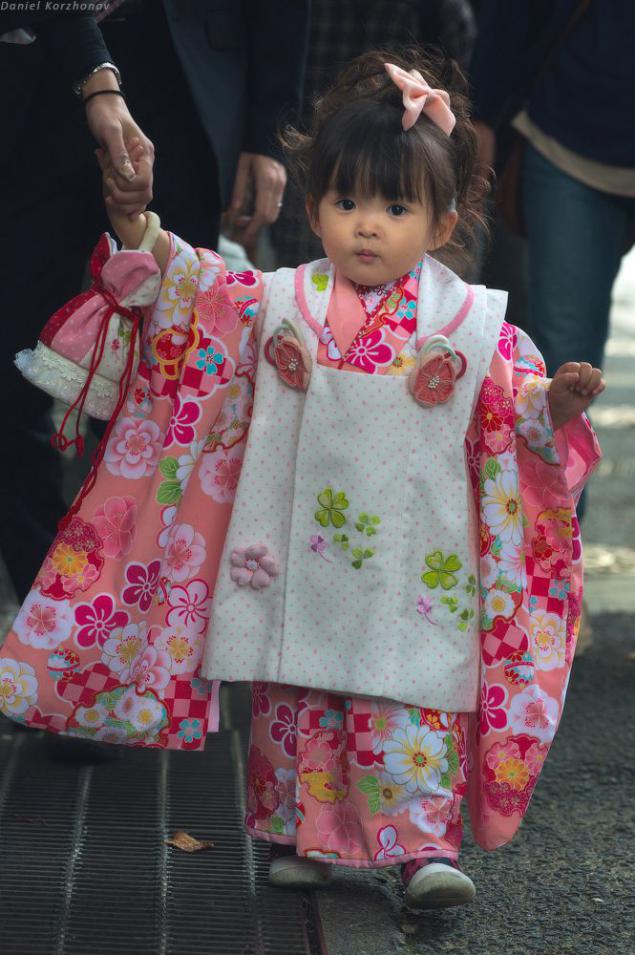
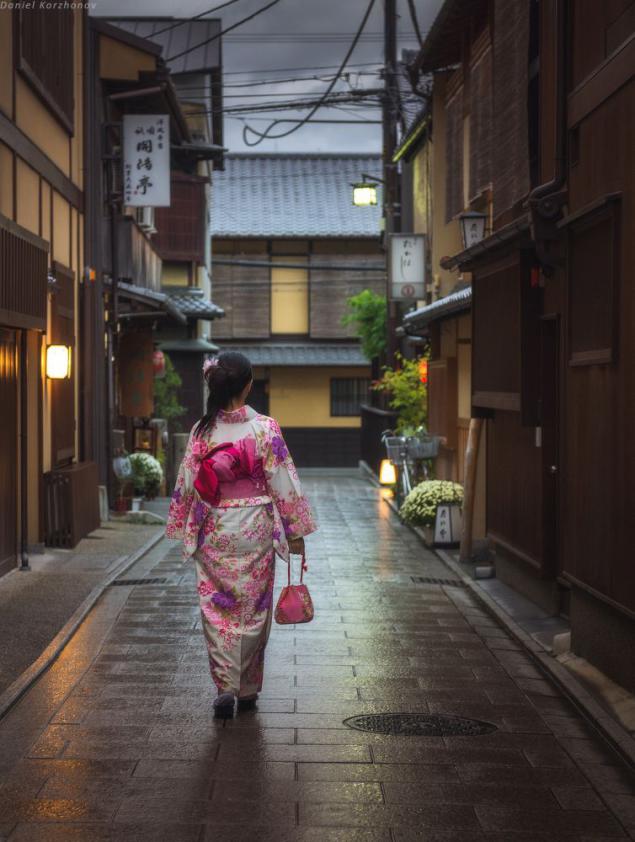
It Ponto-cho - a quarter of a street with an abundance of fine restaurants, tea houses next to the Kamo River. Here you can spend a fortune for one dinner.
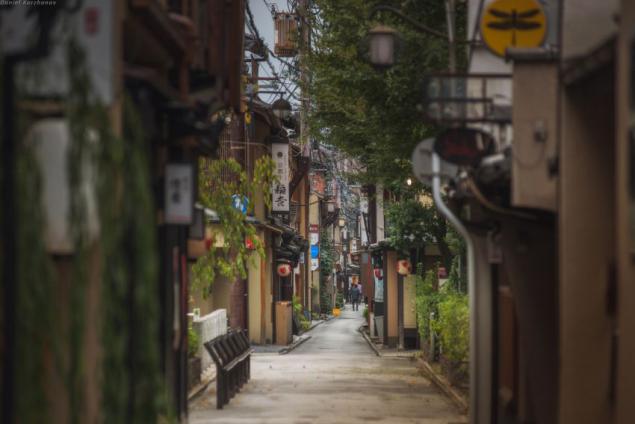


The center of Gion Kobu - street leaning over the canals and bridges of willows. This willow world.

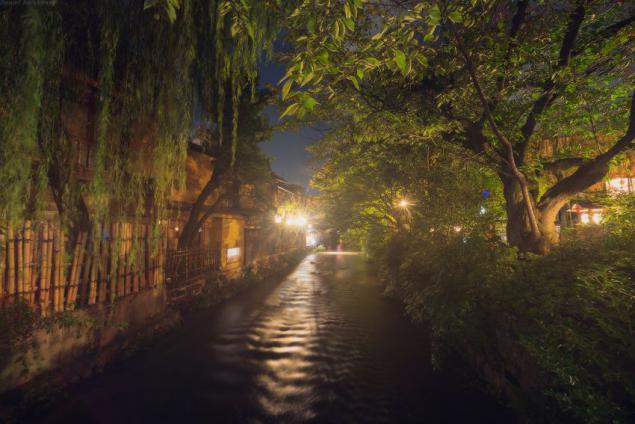

Source: satorifoto.livejournal.com

People come to the teahouses ("ochaya") to get an aesthetic pleasure to talk with geiko and maiko on different themes - art, music, literature, take part in a tea ceremony, listen to music (for example, to play the geisha shamisene) and see traditional dances.

To become a geisha, you must pass a difficult path: from the earliest years, children were taught dancing, singing, playing various musical instruments, etiquette and special dialect, which ought to talk with customers, visitors ochaya. Learning takes place at the expense of okiya ("okiya" - geisha house). The owner of okiya, a business woman with a firm grip, provide young girls with everything necessary for work, serving as a kind of agent between the okiya and ochaya (teahouses).
Careers of the future began to apprentice geisha, assistant. Then the girl became "Mike" ("Woman Dance", a young geisha). At about age 20 takes that same event that we are witnessing - erikae, which means "for tightening the collar." The fact that Mike at each dressing to an item of clothing is sewn collar. It was originally red, but eventually it embroidered with silver, gold and white thread. Embroidery tell the story of Mike. When the child becomes an adult, the red almost disappears under the embroidery. But when Mike becomes a geiko, it changes to a completely white collar. This - a symbol of its independence, maturity. On the day erikae geiko should bypass the teahouses in their karyukai (in his area) and to welcome all owners ochaya with whom she worked, all-all his friends. The ceremony lasts about 4-5 hours.

Now Gihon there are not so many teahouses, but say the tradition is gradually being revived - and the number of geishas every year gradually increases. But the problem is also in the fact that Kyoto - one of the most popular destinations for tourists from all over the world. Therefore Geisha primarily affected by journalists and paparazzi. And no wonder - the geisha less than a thousand (although before the war, there were about 80 thousand!). Therefore, for any appearance of a geisha on the street begins the real "hunting for geisha." The poor girl has no choice but to travel by taxi from the house to the house. Needless to say, the date of the erikae trying to keep secret - but there are rumors rumors and dedicated photographers gather in front of Kyoto okiya hoping to get some beautiful shots of a Geisha.
So you can imagine such an amazing picture: geisha, along with his "bodyguard", passing through the narrow alleys of Gion, persecuted crowd of tourists and journalists, as the brightest star of cinema. Many photographers charge even with folding ladder to climb above others ...
If you want to see geisha in these days, that's the best way - to come to the Miyako Odori ("Dance of the Cherry"), a theatrical performance with dancing and maiko geiko. The event takes place in April. Another wonderful holiday - Gion Mattsuri, held in July. On holidays drained a huge number of people. Generally speaking, in Kyoto in Gion, a wonderful walk in the rain or in the early morning - when the streets of very few people. Every street looks as if it is not less than a thousand years. And to the east of Gion is a pagoda and Yasaka Shrine, also an amazing place, one of the favorite places for the observation of the Japanese flowering cherry. So I, moving in the night from the streets to the street between pagodas and rickety bamboo sheds, felt a chill running through on the back seemed to legends and stories about ninjas and samurai here alive. This is the real Japan.
But back to our "hunting geisha", we catch up with our beauty and look at it from the outside. Movement geiko sharpened even during the greeting or opening doors ochiya. A walk is also unusual: a kimono requires very straight posture. Knees bent at at geiko and toes slightly apart. Therefore, gait appears from mincing, clubfoot - but no swings and kimono clothing items do not slip. The outer, physical beauty is no less important in the art of geisha than her knowledge and skills.


Stomp geisha special sandals ("okobo"), and on his feet dressed funny at first glance, white socks, in which the thumb is detached from the rest - as mittens. Of course, in sandals height 10-15 cm is very difficult to walk, but still and taking into account the weight of the kimono, which may even reach 15-20 kg! It is not surprising that there is even such a profession - "odevalschik" geisha. Each kimono, every detail must be adjusted, assembled as an expensive car, and decorated on the body of a woman. The most important thing to aspire to a geisha - perfection. Excellence in appearance, in dance, in the knowledge of the intricacies of the tea ceremony. To a large extent on the nature of geiko and maiko, their vital status can tell you the kimono. Kimono can hardly contain details, but everything is in the details: sew ornaments, symbols embroidered on fabric. The characters, for example, correspond to the seasons: maple leaves in November, plums in February or in early March, the nightingales. Overall, the Japanese tradition of 28 seasons. Each kimono - individual work, is the whole work of art. Of course, this kimono maiko or geiko any comparison do not go with those that are now popularly photographed for Facebook among young people undergoing a promenade at the tourist spots of Kyoto. The cost of the kimono can reach several thousands (or even tens of thousands) of dollars.



Interesting hairstyle and geiko: say it contains many sharp objects that the girl was able to defend themselves from clients who go too far. From the hairstyle looks perfect. Maiko and geiko are its 5 days a week. It just does not pass: over time, in geiko bald pate, because that constantly put pressure on the hair. But notice this is not possible, if the hair is collected. Geiko and maiko are left on the neck 2 or 3 vertical stripes with filled powder, and left ears open. The Japanese have accepted that the neck and ears - the most beautiful parts of the body. And stripes can visually lengthen the neck to make it more graceful.


Generally, until recently, work has been shrouded in mystery geisha and speculation. And even now there are ambiguities caused by incorrect interpretation of the term, historical events. Thus, people only superficially familiar with the culture of Japan may confuse geisha with courtesans. In the west, it is due in part to the well-known book of Arthur Golden, "Memoirs of a Geisha" (and the same film), where the author of many artistic speculation, especially about the intimate life of a geisha. In fact, everything was quite different: the geisha life has never been linked to close relationships with clients. Their task - to ensure cultural leisure people. Even within the system okiya, geisha houses, forbade men to appear at a party. Of course, wealthy clients often tried to "bribe" the girls gifts, but life geiko was strictly regulated and it just was not the place long-term relationships with men. Adult independent geisha thus able to have a family, but she no longer lived in the okiya.

Now tourists can offer short tea ceremony with maiko or geiko, but you need to understand that they will be significantly different from the authentic Japanese tea ceremony, which is still the main key is not fun, and talk, play, cultural leisure. And, unfortunately, in the arsenal of knowledge is not part of a Geisha Languages. Traditionally, a person can be a client ochaya only on the advice: since women were more confident that the client will be decent. Sometimes, it even took the form of family traditions: the client of the same tea house can be a whole family, and then to their children for generations.

Tea ceremony itself ("ozashiki" or "banquet" - essentially the same as the name of a room for ceremonies) can start with a dance to continue the conversation on the topic of music and art, and end with a game of cards. The dance is different from ballet - although similar to it in that it requires almost the same skill balancing, balance, and what is required of a ballerina. Movement is more measured, not as sharp as in ballet. Movement in dance - a set of specific postures ("kata"), which are then combined into a single plot. Geiko should be familiar with the art of ikebana, new items of literature, to be able to draw well. Often, customers are treated to delicacies or dinner. In ochaya not cook, and bought in good restaurants. This tea ceremony can cost the client $ 500 per hour (this is the "classical" price is not the most famous maiko). All subjects participating in the ceremony, as if with his soul - made by hand with love. Each thing has its own importance. Similarly, any movements, gestures geiko during ceremonies, honed over the years, have their own meaning.
Well, having become acquainted with the Japanese beauty, as if descended from the engravings and paintings of the 18th century princess Heyyan, we say goodbye to her at the door of okiya, wishing her a successful career - in the guise of geiko.

Behind the scene, or how hard it was to shoot this small report. The Japanese are very aggressive, in actual fact. Only dedicated to know about the ceremony. Otherwise, it would be even worse. I was just lucky - often say to passers-by! ;)

In Kyoto, a scene - is not uncommon. Teens like to walk in a kimono, more often - with his loved ones.
Sometimes the streets allowed special "Geisha" - to shoot. Take a fee for it.

To see the streets of geisha should either come to the Miyako Odori Festival (April) - when a geisha and maiko dancing at local theaters, and sometimes return home through the narrow streets of Gion Kobu. Or come to the festival Djidan Matsuri in October. The procession of the festival you can always catch a beautiful view of a Geisha.

And the kids in kimonos, too wonderful! :)



It Ponto-cho - a quarter of a street with an abundance of fine restaurants, tea houses next to the Kamo River. Here you can spend a fortune for one dinner.



The center of Gion Kobu - street leaning over the canals and bridges of willows. This willow world.



Source: satorifoto.livejournal.com


